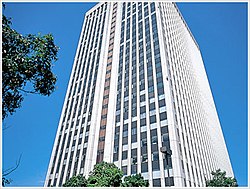Yazaki
 Yazaki Corporation's headquarters in Minato, Tokyo, Japan | |
Native name | 矢崎総業株式会社 |
|---|---|
| Type | Private KK |
| Industry | Automotive |
| Founded | (1929) |
| Founder | Sadami Yazaki |
| Headquarters | , |
Area served | Worldwide |
Key people | Yasuhiko Yazaki (Chairman) Shinji Yazaki (President) |
| Products | |
| Revenue | |
Number of employees | 306,118 people (as of June 2018) |
| Website | Official website |
| Footnotes / references [1][2]/ar.html[3] | |
Yazaki Corporation (矢崎総業株式会社, Yazaki Sōgyō Kabushiki Kaisha) is a global automotive parts supplier with a focus on wire harnesses, instruments and components such as connectors and terminals. The company's origin and headquarters are in Japan, but in 2011, roughly 90% of its employees were outside the home country.
Yazaki ranks among the largest worldwide automotive suppliers, ranked 13th by the industry journal Automotive News in 2015.[4]
The company's product lineup includes electrical cables, meter and auto instruments, gas equipment, air-conditioning, and solar-powered systems. As a first tier supplier, Yazaki sells chiefly to auto makers, and, to a lesser extent, electric power, gas, and general construction companies. Yazaki is among the top 100 companies receiving the most US patents.[5]
The Yazaki Group's corporate headquarters are located in the Mita-Kokusai Building (三田国際ビル Mita Kokusai Biru) in Mita, in Minato, Tokyo, Japan. Its main R&D center and its World Headquarters are located in the Y-city compound in Susono, Shizuoka prefecture.[6] The company has its European headquarters in Cologne, Germany and the North American headquarters in Canton, Michigan, United States of America
History and expansion[]
Starting as a small Japanese family business selling wiring harnesses for automobiles in 1929, Yazaki Group in 2011 employs more than 192,000 people worldwide, with about 90% of them (171,000) outside Japan.[7] After World War II, Yazaki focused on automotive wire harness production and grew rapidly. Overseas growth increased strongly between 1974 and the 1990s. There were external and internal reasons for this increase. The main external reason was the general trend of Japanese automotive companies to move production abroad to avoid trade sanctions in this period.[8] This strategy change was accompanied by a change of leadership within Yazaki, when the young heir Yasuhiko Yazaki succeeded the founder Sadami Yazaki in 1974, aged only 33. Between 1974 and 1990, overseas sales grew roughly 30 times (from about ¥4 Billion in 1974 to ¥116 Billion), while overseas employees increased tenfold (from 2,922 to 33,703).[9]
Main business areas[]
Yazaki's business is concentrated in the automotive industry and focuses on three areas: Electrical Distribution Systems (e.g. wire harnesses), Electronics & Instrumentation, and Components. As a first tier supplier, Yazaki interacts directly with car makers such as Toyota, Honda, GM, Ford, Stellantis, Tesla, Subaru, Nissan, Mazda, Jaguar Land Rover, PSA, etc. and coordinates parts of development, sub-component sourcing, testing and assembly.

Electrical Distribution Systems: Wire harness production is a labor-intensive process and requires high degrees of coordination of and closeness to the car manufacturer. Yazaki is among the global leaders in this area with a market share of close to 30%.[5][9][10]
Electronics & Instrumentation: Yazaki provides Instrument Clusters, Display and Clock Modules, Power Distribution Boxes, as well as Body Electronics, Head Up Displays (HUD) and Combi Switches. The company also offers HMI solutions, and system support for Intelligent Electronic, Power & Signal Distribution.[10]
Components: Yazaki develops and produces specialized automotive connectors and terminals.[10]
Training[]
Every year Yazaki World Headquarters (Yazaki WHQ, located in Y-City, Susono, Japan) conducting two leadership training for all global affiliate plants. 1. YLDS (Yazaki Leadership Development Seminar) - for Junior management people 2. YGLP (Yazaki Global Leadership Seminar) - for senior management people
Price fixing[]
On January 30, 2012, the US Justice Department announced after two years of investigation that it had discovered part of a massive price fixing scheme in which Denso and Yazaki played a significant role. The conspiracy, which fixed prices and allocated components to such car manufacturers as Toyota and Honda, extended from Michigan to Japan, where it was also under investigation. Denso agreed to pay a fine of $78 million.[11] Yazaki agreed to pay a fine of $470 million, and four Yazaki executives were sentenced to prison and assessed a $20,000 fine each.[12]
References[]
- ^ "Company Profile" (in Japanese). Yazaki Corporation. Retrieved January 22, 2019.
- ^ "Annual Report". Yazaki Corporation. Retrieved January 22, 2019.
- ^ "Company Overview". Bloomberg L.P. Retrieved December 23, 2015.
- ^ "Top 100 global OEM parts suppliers" (PDF). Automotive News. Crain Communications. May 23, 2017. Retrieved December 24, 2015.
- ^ Jump up to: a b "Company Profiles". Hoover's, Inc. Retrieved April 5, 2012.
- ^ "Global Network - Japan". Yazaki Corporation. Retrieved June 18, 2015.
- ^ "Yazaki Corporation Social & Environmental Report 2011" (PDF). Yazaki corporation. 2011. Retrieved December 24, 2015.
- ^ Womack, James P.; Jones, Daniel T.; Roos, Daniel (1990). The Machine that Changed the World. Harper Perennial. ISBN 978-1-84737-055-6.
- ^ Jump up to: a b Ichijo, Kazuo (2007), The Yazaki Corporation Article written for the IMD – Lombard Odier Darier Hentsch Distinguished Family Business Award 2007 (PDF), Yazaki Corporation
- ^ Jump up to: a b c "Yazaki Europe Product Overview Homepage". Yazaki Corporation. Retrieved April 5, 2012.
- ^ "U.S. fines Japanese auto parts suppliers $470 million". Japan Times. Associated Press. February 1, 2012. p. 1.
- ^ "Two auto parts suppliers fined $548M for price fixing". USA Today. January 30, 2012. Retrieved December 24, 2015.
External links[]
- Yazaki Group website (in Japanese)
- Yazaki North America official website (in English)
- Yazaki Europe official website (in English)
- Automotive companies based in Tokyo
- Manufacturing companies based in Tokyo
- Auto parts suppliers of Japan
- Manufacturing companies established in 1929
- 1929 establishments in Japan
- Japanese brands
- Multinational companies headquartered in Japan